Financial Management Report for Sweet Menu Restaurant Expansion Plan
VerifiedAdded on 2020/02/05
|18
|5598
|94
Report
AI Summary
This report examines the financial management strategies employed by Sweet Menu Restaurant (SMR), focusing on the sources of finance available for business expansion. It analyzes both internal sources like retained earnings and sales of assets, and external sources such as bank loans, angel investors, venture capital, and shares. The report delves into the pros and cons of each funding source, evaluating their cost implications and suitability for SMR's expansion plans. Furthermore, it emphasizes the importance of financial planning, including capital structure, investment decisions, operational activities, and future issue management. The report also identifies key decision-makers, including banks, shareholders, government, and employees, and how they utilize SMR's financial information to make informed decisions. Overall, the report provides a comprehensive overview of financial management principles and their application within the context of SMR's business objectives.

MFRD
Paraphrase This Document
Need a fresh take? Get an instant paraphrase of this document with our AI Paraphraser

TABLE OF CONTENTS
TASK 1............................................................................................................................................1
1.1................................................................................................................................................1
1.2................................................................................................................................................2
1.3................................................................................................................................................3
TASK 2............................................................................................................................................4
2.1................................................................................................................................................4
2.2................................................................................................................................................4
2.3................................................................................................................................................5
2.4................................................................................................................................................6
TASK 3............................................................................................................................................7
3.1................................................................................................................................................7
3.2................................................................................................................................................8
3.3................................................................................................................................................8
TASK 4 .........................................................................................................................................10
4.1..............................................................................................................................................10
4.2..............................................................................................................................................11
4.3..............................................................................................................................................12
CONCLUSION..............................................................................................................................13
REFERENCES..............................................................................................................................14
TASK 1............................................................................................................................................1
1.1................................................................................................................................................1
1.2................................................................................................................................................2
1.3................................................................................................................................................3
TASK 2............................................................................................................................................4
2.1................................................................................................................................................4
2.2................................................................................................................................................4
2.3................................................................................................................................................5
2.4................................................................................................................................................6
TASK 3............................................................................................................................................7
3.1................................................................................................................................................7
3.2................................................................................................................................................8
3.3................................................................................................................................................8
TASK 4 .........................................................................................................................................10
4.1..............................................................................................................................................10
4.2..............................................................................................................................................11
4.3..............................................................................................................................................12
CONCLUSION..............................................................................................................................13
REFERENCES..............................................................................................................................14
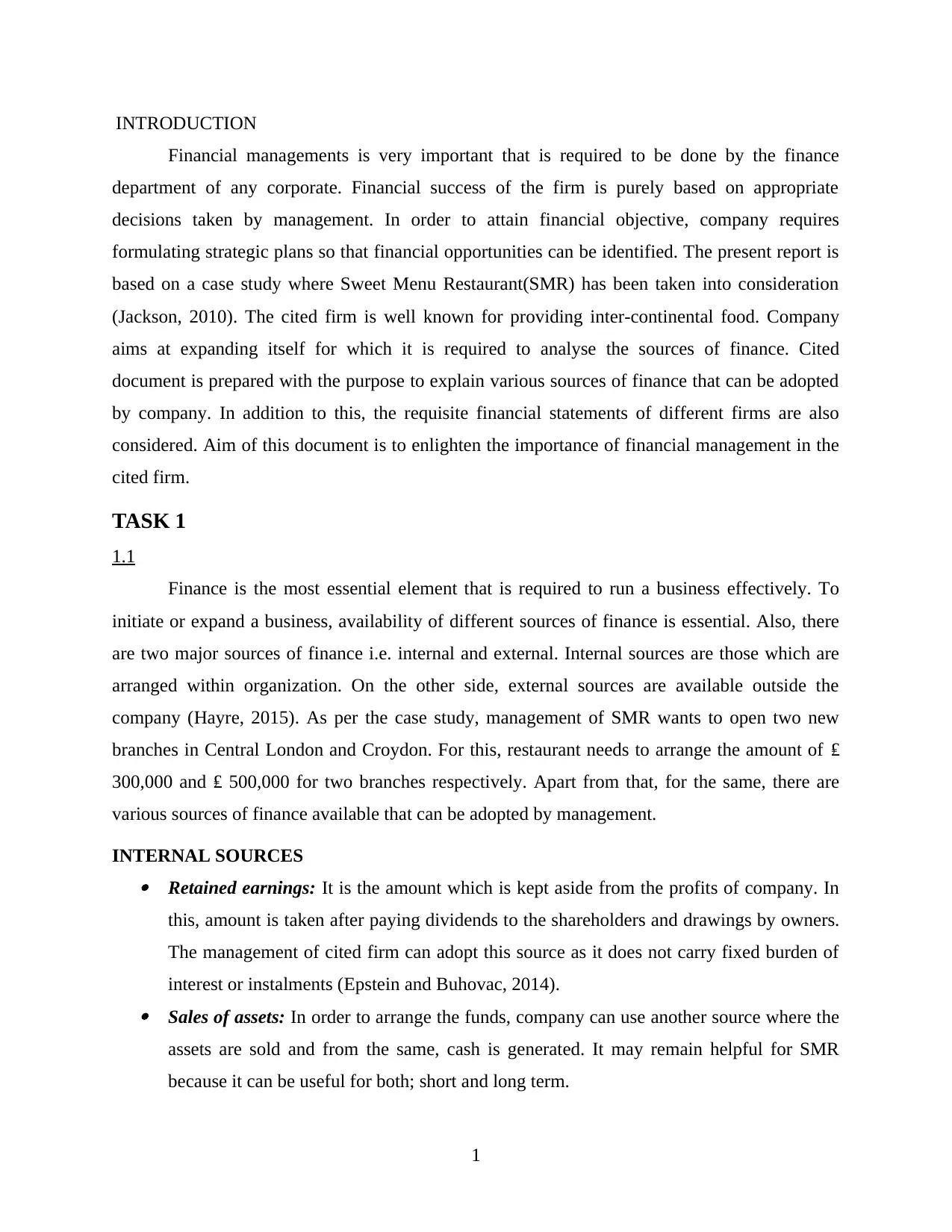
INTRODUCTION
Financial managements is very important that is required to be done by the finance
department of any corporate. Financial success of the firm is purely based on appropriate
decisions taken by management. In order to attain financial objective, company requires
formulating strategic plans so that financial opportunities can be identified. The present report is
based on a case study where Sweet Menu Restaurant(SMR) has been taken into consideration
(Jackson, 2010). The cited firm is well known for providing inter-continental food. Company
aims at expanding itself for which it is required to analyse the sources of finance. Cited
document is prepared with the purpose to explain various sources of finance that can be adopted
by company. In addition to this, the requisite financial statements of different firms are also
considered. Aim of this document is to enlighten the importance of financial management in the
cited firm.
TASK 1
1.1
Finance is the most essential element that is required to run a business effectively. To
initiate or expand a business, availability of different sources of finance is essential. Also, there
are two major sources of finance i.e. internal and external. Internal sources are those which are
arranged within organization. On the other side, external sources are available outside the
company (Hayre, 2015). As per the case study, management of SMR wants to open two new
branches in Central London and Croydon. For this, restaurant needs to arrange the amount of ₤
300,000 and ₤ 500,000 for two branches respectively. Apart from that, for the same, there are
various sources of finance available that can be adopted by management.
INTERNAL SOURCES Retained earnings: It is the amount which is kept aside from the profits of company. In
this, amount is taken after paying dividends to the shareholders and drawings by owners.
The management of cited firm can adopt this source as it does not carry fixed burden of
interest or instalments (Epstein and Buhovac, 2014). Sales of assets: In order to arrange the funds, company can use another source where the
assets are sold and from the same, cash is generated. It may remain helpful for SMR
because it can be useful for both; short and long term.
1
Financial managements is very important that is required to be done by the finance
department of any corporate. Financial success of the firm is purely based on appropriate
decisions taken by management. In order to attain financial objective, company requires
formulating strategic plans so that financial opportunities can be identified. The present report is
based on a case study where Sweet Menu Restaurant(SMR) has been taken into consideration
(Jackson, 2010). The cited firm is well known for providing inter-continental food. Company
aims at expanding itself for which it is required to analyse the sources of finance. Cited
document is prepared with the purpose to explain various sources of finance that can be adopted
by company. In addition to this, the requisite financial statements of different firms are also
considered. Aim of this document is to enlighten the importance of financial management in the
cited firm.
TASK 1
1.1
Finance is the most essential element that is required to run a business effectively. To
initiate or expand a business, availability of different sources of finance is essential. Also, there
are two major sources of finance i.e. internal and external. Internal sources are those which are
arranged within organization. On the other side, external sources are available outside the
company (Hayre, 2015). As per the case study, management of SMR wants to open two new
branches in Central London and Croydon. For this, restaurant needs to arrange the amount of ₤
300,000 and ₤ 500,000 for two branches respectively. Apart from that, for the same, there are
various sources of finance available that can be adopted by management.
INTERNAL SOURCES Retained earnings: It is the amount which is kept aside from the profits of company. In
this, amount is taken after paying dividends to the shareholders and drawings by owners.
The management of cited firm can adopt this source as it does not carry fixed burden of
interest or instalments (Epstein and Buhovac, 2014). Sales of assets: In order to arrange the funds, company can use another source where the
assets are sold and from the same, cash is generated. It may remain helpful for SMR
because it can be useful for both; short and long term.
1
⊘ This is a preview!⊘
Do you want full access?
Subscribe today to unlock all pages.

Trusted by 1+ million students worldwide
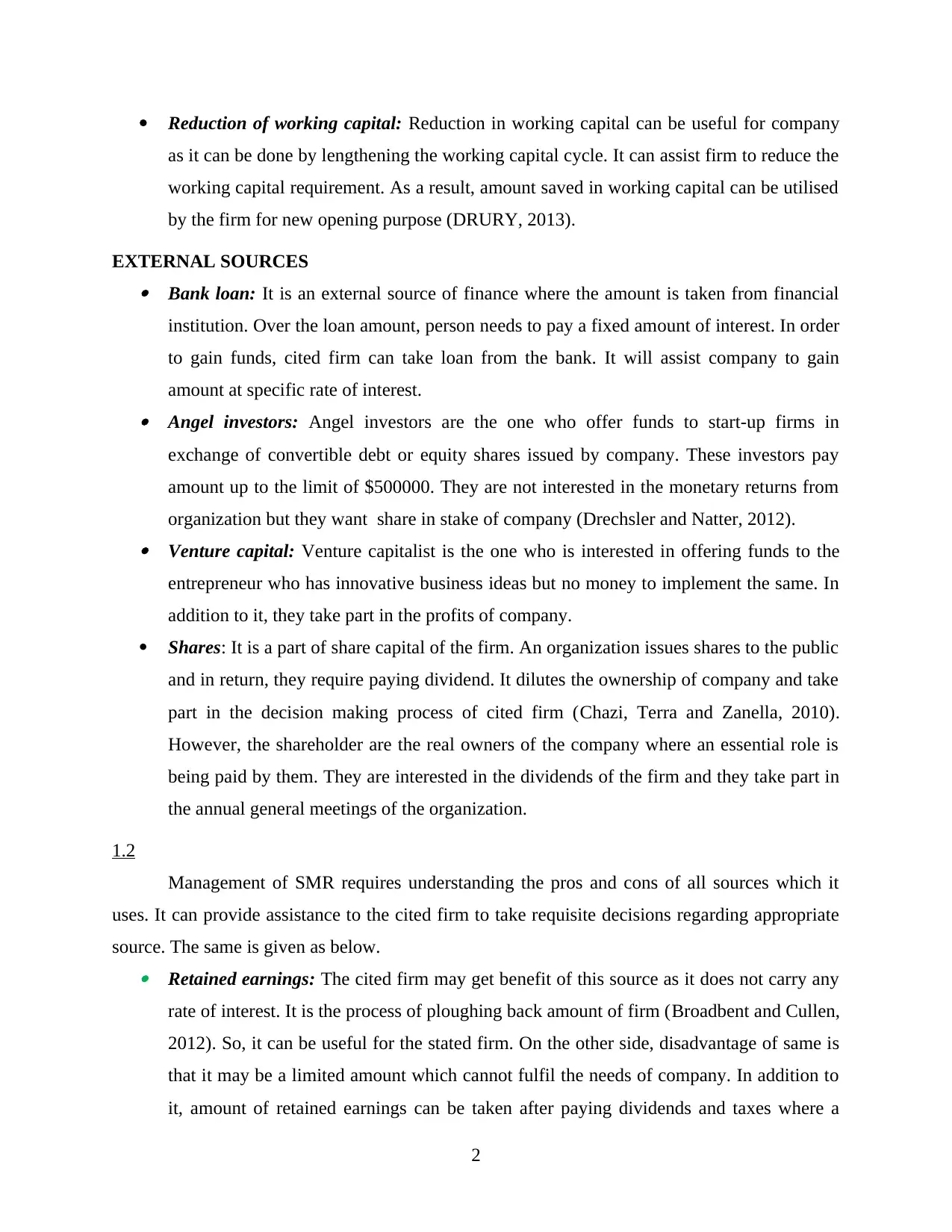
Reduction of working capital: Reduction in working capital can be useful for company
as it can be done by lengthening the working capital cycle. It can assist firm to reduce the
working capital requirement. As a result, amount saved in working capital can be utilised
by the firm for new opening purpose (DRURY, 2013).
EXTERNAL SOURCES Bank loan: It is an external source of finance where the amount is taken from financial
institution. Over the loan amount, person needs to pay a fixed amount of interest. In order
to gain funds, cited firm can take loan from the bank. It will assist company to gain
amount at specific rate of interest. Angel investors: Angel investors are the one who offer funds to start-up firms in
exchange of convertible debt or equity shares issued by company. These investors pay
amount up to the limit of $500000. They are not interested in the monetary returns from
organization but they want share in stake of company (Drechsler and Natter, 2012). Venture capital: Venture capitalist is the one who is interested in offering funds to the
entrepreneur who has innovative business ideas but no money to implement the same. In
addition to it, they take part in the profits of company.
Shares: It is a part of share capital of the firm. An organization issues shares to the public
and in return, they require paying dividend. It dilutes the ownership of company and take
part in the decision making process of cited firm (Chazi, Terra and Zanella, 2010).
However, the shareholder are the real owners of the company where an essential role is
being paid by them. They are interested in the dividends of the firm and they take part in
the annual general meetings of the organization.
1.2
Management of SMR requires understanding the pros and cons of all sources which it
uses. It can provide assistance to the cited firm to take requisite decisions regarding appropriate
source. The same is given as below. Retained earnings: The cited firm may get benefit of this source as it does not carry any
rate of interest. It is the process of ploughing back amount of firm (Broadbent and Cullen,
2012). So, it can be useful for the stated firm. On the other side, disadvantage of same is
that it may be a limited amount which cannot fulfil the needs of company. In addition to
it, amount of retained earnings can be taken after paying dividends and taxes where a
2
as it can be done by lengthening the working capital cycle. It can assist firm to reduce the
working capital requirement. As a result, amount saved in working capital can be utilised
by the firm for new opening purpose (DRURY, 2013).
EXTERNAL SOURCES Bank loan: It is an external source of finance where the amount is taken from financial
institution. Over the loan amount, person needs to pay a fixed amount of interest. In order
to gain funds, cited firm can take loan from the bank. It will assist company to gain
amount at specific rate of interest. Angel investors: Angel investors are the one who offer funds to start-up firms in
exchange of convertible debt or equity shares issued by company. These investors pay
amount up to the limit of $500000. They are not interested in the monetary returns from
organization but they want share in stake of company (Drechsler and Natter, 2012). Venture capital: Venture capitalist is the one who is interested in offering funds to the
entrepreneur who has innovative business ideas but no money to implement the same. In
addition to it, they take part in the profits of company.
Shares: It is a part of share capital of the firm. An organization issues shares to the public
and in return, they require paying dividend. It dilutes the ownership of company and take
part in the decision making process of cited firm (Chazi, Terra and Zanella, 2010).
However, the shareholder are the real owners of the company where an essential role is
being paid by them. They are interested in the dividends of the firm and they take part in
the annual general meetings of the organization.
1.2
Management of SMR requires understanding the pros and cons of all sources which it
uses. It can provide assistance to the cited firm to take requisite decisions regarding appropriate
source. The same is given as below. Retained earnings: The cited firm may get benefit of this source as it does not carry any
rate of interest. It is the process of ploughing back amount of firm (Broadbent and Cullen,
2012). So, it can be useful for the stated firm. On the other side, disadvantage of same is
that it may be a limited amount which cannot fulfil the needs of company. In addition to
it, amount of retained earnings can be taken after paying dividends and taxes where a
2
Paraphrase This Document
Need a fresh take? Get an instant paraphrase of this document with our AI Paraphraser

situation may arise where the firm requires paying high taxes. It can result into
decreasing amount which leads to affect the financial availability (Brigham, E. F. and
Houston, 2012). Sale of assets: The major pros and cons of this source is that company may get finance
without extra borrowings of money. In context to it, the sold assets can be aback by
company whenever it is needed. However, major disadvantage is loss of assets against
money. Bank loan: The major advantage of borrowing from banks is that the cited firm requires
paying fixed amount of interest as it is generally fixed over specific period. Apart from
that, management of SMR needs to provide collateral securities against the loan amount.
Venture capital: Benefit of this source is that the investors want to contribute in running
business. However, limitation of the stated source is that investors are interested in small
percentage of ownership of company (Ahmed, 2010).
1.3
On the basis of above analysis, appropriate sources of funds for company are mentioned
further. However, using these funds can lower down the cost of new business from which
company can increase its initial returns. Furthermore, appropriate funds are stated as below.
Bank loan: The cited firm can use borrowings from bank in order to open a new
business. It may remain fruitful for organization because fix rate of interest is paid by the
firm. Along with that, it leads to manage the financial resources of company along with
identifying the areas where further amount needs to be invested (The Importance of the
Cash Flow Statement. 2016). Shares: Company can adopt this source because at initial level, organization is not
required to pay good amount of dividend to the shareholders. It can assist the firm to
collect and save a good amount of money by issuing shares.
Retained earnings: As per the stated case study, the management of SMR wants to open
new branches at different places. However, it can cost the company so that cited firm
should adopt the source which can lower the cost at initial level. The firm can use
retained earnings so that any rate of interest is not necessarily be paid by the firm (Li,
2016).
3
decreasing amount which leads to affect the financial availability (Brigham, E. F. and
Houston, 2012). Sale of assets: The major pros and cons of this source is that company may get finance
without extra borrowings of money. In context to it, the sold assets can be aback by
company whenever it is needed. However, major disadvantage is loss of assets against
money. Bank loan: The major advantage of borrowing from banks is that the cited firm requires
paying fixed amount of interest as it is generally fixed over specific period. Apart from
that, management of SMR needs to provide collateral securities against the loan amount.
Venture capital: Benefit of this source is that the investors want to contribute in running
business. However, limitation of the stated source is that investors are interested in small
percentage of ownership of company (Ahmed, 2010).
1.3
On the basis of above analysis, appropriate sources of funds for company are mentioned
further. However, using these funds can lower down the cost of new business from which
company can increase its initial returns. Furthermore, appropriate funds are stated as below.
Bank loan: The cited firm can use borrowings from bank in order to open a new
business. It may remain fruitful for organization because fix rate of interest is paid by the
firm. Along with that, it leads to manage the financial resources of company along with
identifying the areas where further amount needs to be invested (The Importance of the
Cash Flow Statement. 2016). Shares: Company can adopt this source because at initial level, organization is not
required to pay good amount of dividend to the shareholders. It can assist the firm to
collect and save a good amount of money by issuing shares.
Retained earnings: As per the stated case study, the management of SMR wants to open
new branches at different places. However, it can cost the company so that cited firm
should adopt the source which can lower the cost at initial level. The firm can use
retained earnings so that any rate of interest is not necessarily be paid by the firm (Li,
2016).
3
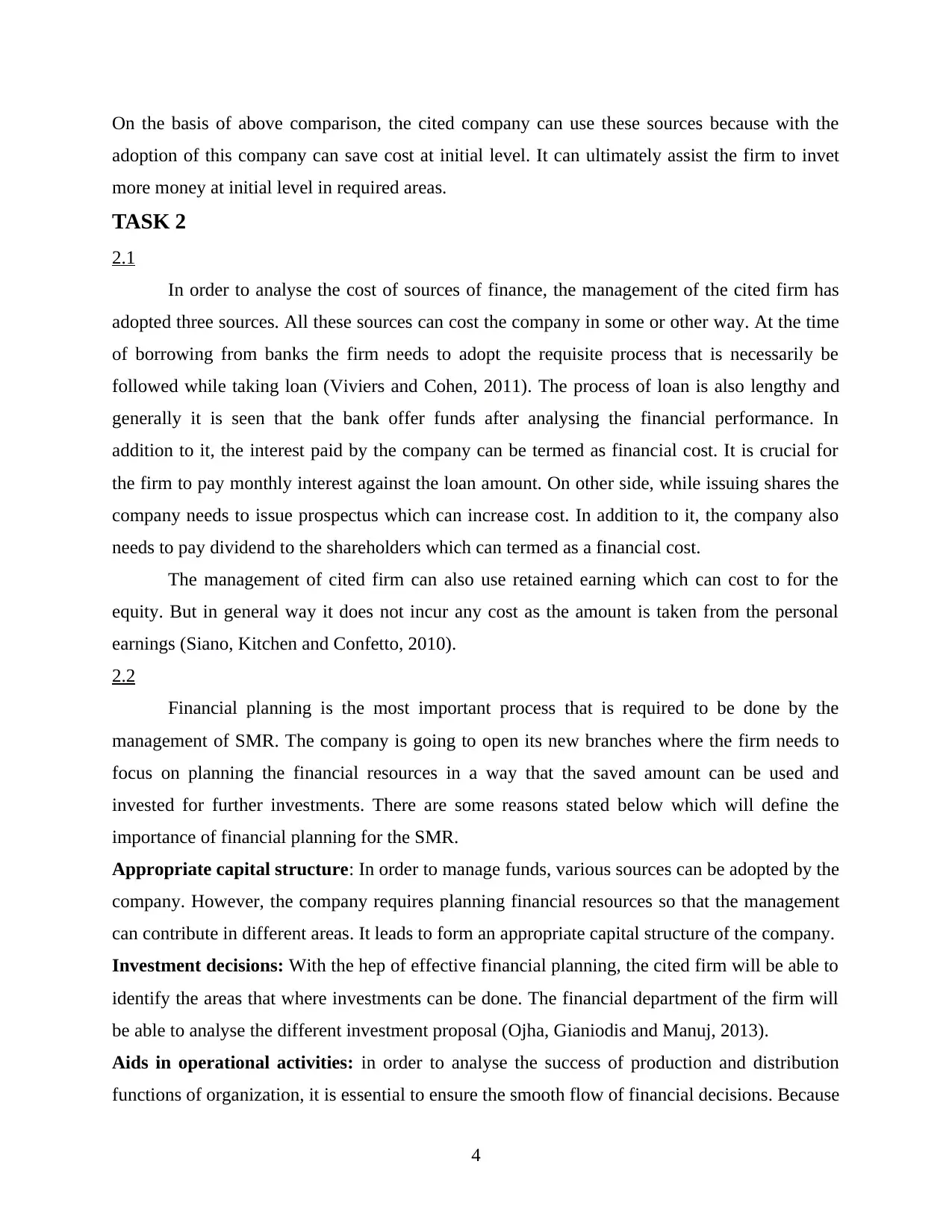
On the basis of above comparison, the cited company can use these sources because with the
adoption of this company can save cost at initial level. It can ultimately assist the firm to invet
more money at initial level in required areas.
TASK 2
2.1
In order to analyse the cost of sources of finance, the management of the cited firm has
adopted three sources. All these sources can cost the company in some or other way. At the time
of borrowing from banks the firm needs to adopt the requisite process that is necessarily be
followed while taking loan (Viviers and Cohen, 2011). The process of loan is also lengthy and
generally it is seen that the bank offer funds after analysing the financial performance. In
addition to it, the interest paid by the company can be termed as financial cost. It is crucial for
the firm to pay monthly interest against the loan amount. On other side, while issuing shares the
company needs to issue prospectus which can increase cost. In addition to it, the company also
needs to pay dividend to the shareholders which can termed as a financial cost.
The management of cited firm can also use retained earning which can cost to for the
equity. But in general way it does not incur any cost as the amount is taken from the personal
earnings (Siano, Kitchen and Confetto, 2010).
2.2
Financial planning is the most important process that is required to be done by the
management of SMR. The company is going to open its new branches where the firm needs to
focus on planning the financial resources in a way that the saved amount can be used and
invested for further investments. There are some reasons stated below which will define the
importance of financial planning for the SMR.
Appropriate capital structure: In order to manage funds, various sources can be adopted by the
company. However, the company requires planning financial resources so that the management
can contribute in different areas. It leads to form an appropriate capital structure of the company.
Investment decisions: With the hep of effective financial planning, the cited firm will be able to
identify the areas that where investments can be done. The financial department of the firm will
be able to analyse the different investment proposal (Ojha, Gianiodis and Manuj, 2013).
Aids in operational activities: in order to analyse the success of production and distribution
functions of organization, it is essential to ensure the smooth flow of financial decisions. Because
4
adoption of this company can save cost at initial level. It can ultimately assist the firm to invet
more money at initial level in required areas.
TASK 2
2.1
In order to analyse the cost of sources of finance, the management of the cited firm has
adopted three sources. All these sources can cost the company in some or other way. At the time
of borrowing from banks the firm needs to adopt the requisite process that is necessarily be
followed while taking loan (Viviers and Cohen, 2011). The process of loan is also lengthy and
generally it is seen that the bank offer funds after analysing the financial performance. In
addition to it, the interest paid by the company can be termed as financial cost. It is crucial for
the firm to pay monthly interest against the loan amount. On other side, while issuing shares the
company needs to issue prospectus which can increase cost. In addition to it, the company also
needs to pay dividend to the shareholders which can termed as a financial cost.
The management of cited firm can also use retained earning which can cost to for the
equity. But in general way it does not incur any cost as the amount is taken from the personal
earnings (Siano, Kitchen and Confetto, 2010).
2.2
Financial planning is the most important process that is required to be done by the
management of SMR. The company is going to open its new branches where the firm needs to
focus on planning the financial resources in a way that the saved amount can be used and
invested for further investments. There are some reasons stated below which will define the
importance of financial planning for the SMR.
Appropriate capital structure: In order to manage funds, various sources can be adopted by the
company. However, the company requires planning financial resources so that the management
can contribute in different areas. It leads to form an appropriate capital structure of the company.
Investment decisions: With the hep of effective financial planning, the cited firm will be able to
identify the areas that where investments can be done. The financial department of the firm will
be able to analyse the different investment proposal (Ojha, Gianiodis and Manuj, 2013).
Aids in operational activities: in order to analyse the success of production and distribution
functions of organization, it is essential to ensure the smooth flow of financial decisions. Because
4
⊘ This is a preview!⊘
Do you want full access?
Subscribe today to unlock all pages.

Trusted by 1+ million students worldwide
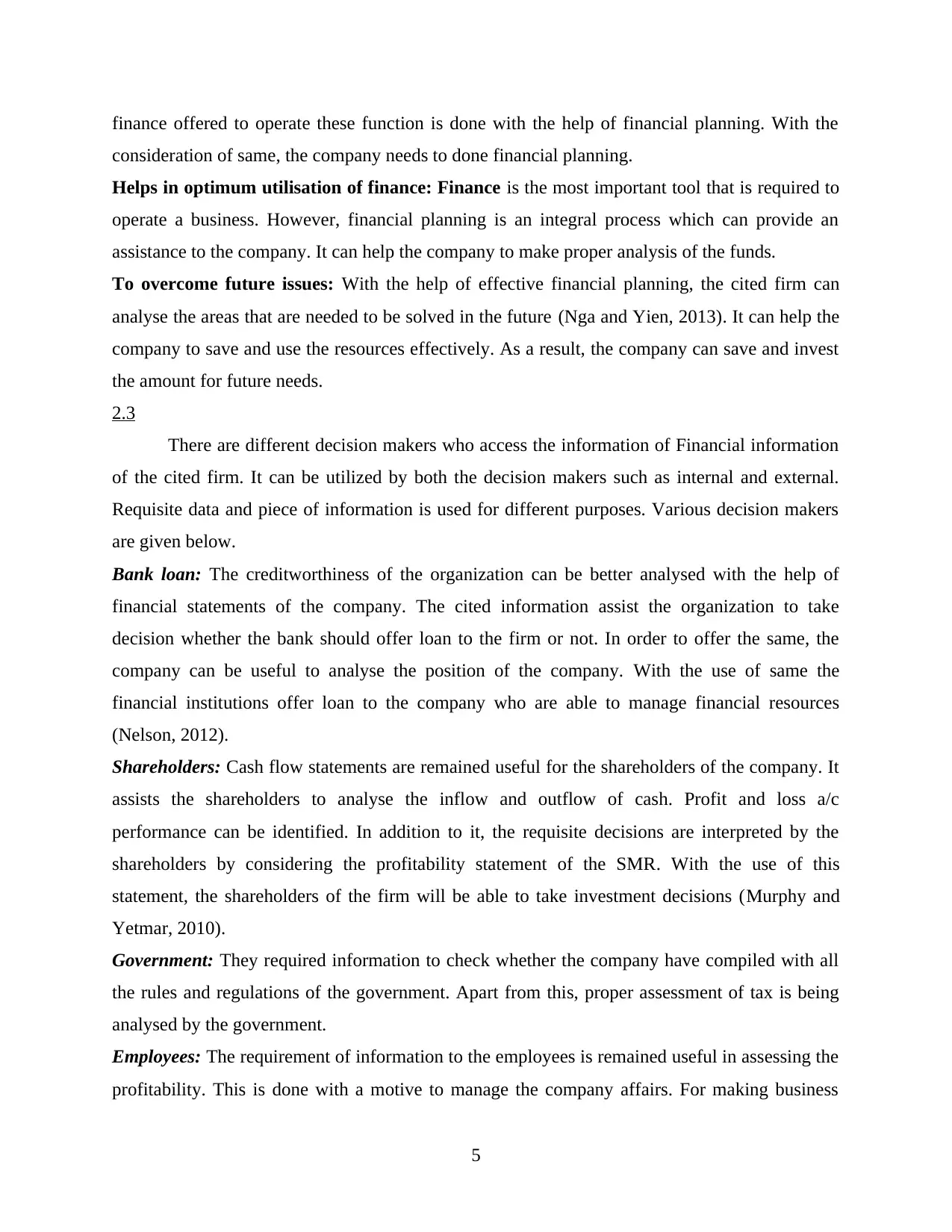
finance offered to operate these function is done with the help of financial planning. With the
consideration of same, the company needs to done financial planning.
Helps in optimum utilisation of finance: Finance is the most important tool that is required to
operate a business. However, financial planning is an integral process which can provide an
assistance to the company. It can help the company to make proper analysis of the funds.
To overcome future issues: With the help of effective financial planning, the cited firm can
analyse the areas that are needed to be solved in the future (Nga and Yien, 2013). It can help the
company to save and use the resources effectively. As a result, the company can save and invest
the amount for future needs.
2.3
There are different decision makers who access the information of Financial information
of the cited firm. It can be utilized by both the decision makers such as internal and external.
Requisite data and piece of information is used for different purposes. Various decision makers
are given below.
Bank loan: The creditworthiness of the organization can be better analysed with the help of
financial statements of the company. The cited information assist the organization to take
decision whether the bank should offer loan to the firm or not. In order to offer the same, the
company can be useful to analyse the position of the company. With the use of same the
financial institutions offer loan to the company who are able to manage financial resources
(Nelson, 2012).
Shareholders: Cash flow statements are remained useful for the shareholders of the company. It
assists the shareholders to analyse the inflow and outflow of cash. Profit and loss a/c
performance can be identified. In addition to it, the requisite decisions are interpreted by the
shareholders by considering the profitability statement of the SMR. With the use of this
statement, the shareholders of the firm will be able to take investment decisions (Murphy and
Yetmar, 2010).
Government: They required information to check whether the company have compiled with all
the rules and regulations of the government. Apart from this, proper assessment of tax is being
analysed by the government.
Employees: The requirement of information to the employees is remained useful in assessing the
profitability. This is done with a motive to manage the company affairs. For making business
5
consideration of same, the company needs to done financial planning.
Helps in optimum utilisation of finance: Finance is the most important tool that is required to
operate a business. However, financial planning is an integral process which can provide an
assistance to the company. It can help the company to make proper analysis of the funds.
To overcome future issues: With the help of effective financial planning, the cited firm can
analyse the areas that are needed to be solved in the future (Nga and Yien, 2013). It can help the
company to save and use the resources effectively. As a result, the company can save and invest
the amount for future needs.
2.3
There are different decision makers who access the information of Financial information
of the cited firm. It can be utilized by both the decision makers such as internal and external.
Requisite data and piece of information is used for different purposes. Various decision makers
are given below.
Bank loan: The creditworthiness of the organization can be better analysed with the help of
financial statements of the company. The cited information assist the organization to take
decision whether the bank should offer loan to the firm or not. In order to offer the same, the
company can be useful to analyse the position of the company. With the use of same the
financial institutions offer loan to the company who are able to manage financial resources
(Nelson, 2012).
Shareholders: Cash flow statements are remained useful for the shareholders of the company. It
assists the shareholders to analyse the inflow and outflow of cash. Profit and loss a/c
performance can be identified. In addition to it, the requisite decisions are interpreted by the
shareholders by considering the profitability statement of the SMR. With the use of this
statement, the shareholders of the firm will be able to take investment decisions (Murphy and
Yetmar, 2010).
Government: They required information to check whether the company have compiled with all
the rules and regulations of the government. Apart from this, proper assessment of tax is being
analysed by the government.
Employees: The requirement of information to the employees is remained useful in assessing the
profitability. This is done with a motive to manage the company affairs. For making business
5
Paraphrase This Document
Need a fresh take? Get an instant paraphrase of this document with our AI Paraphraser
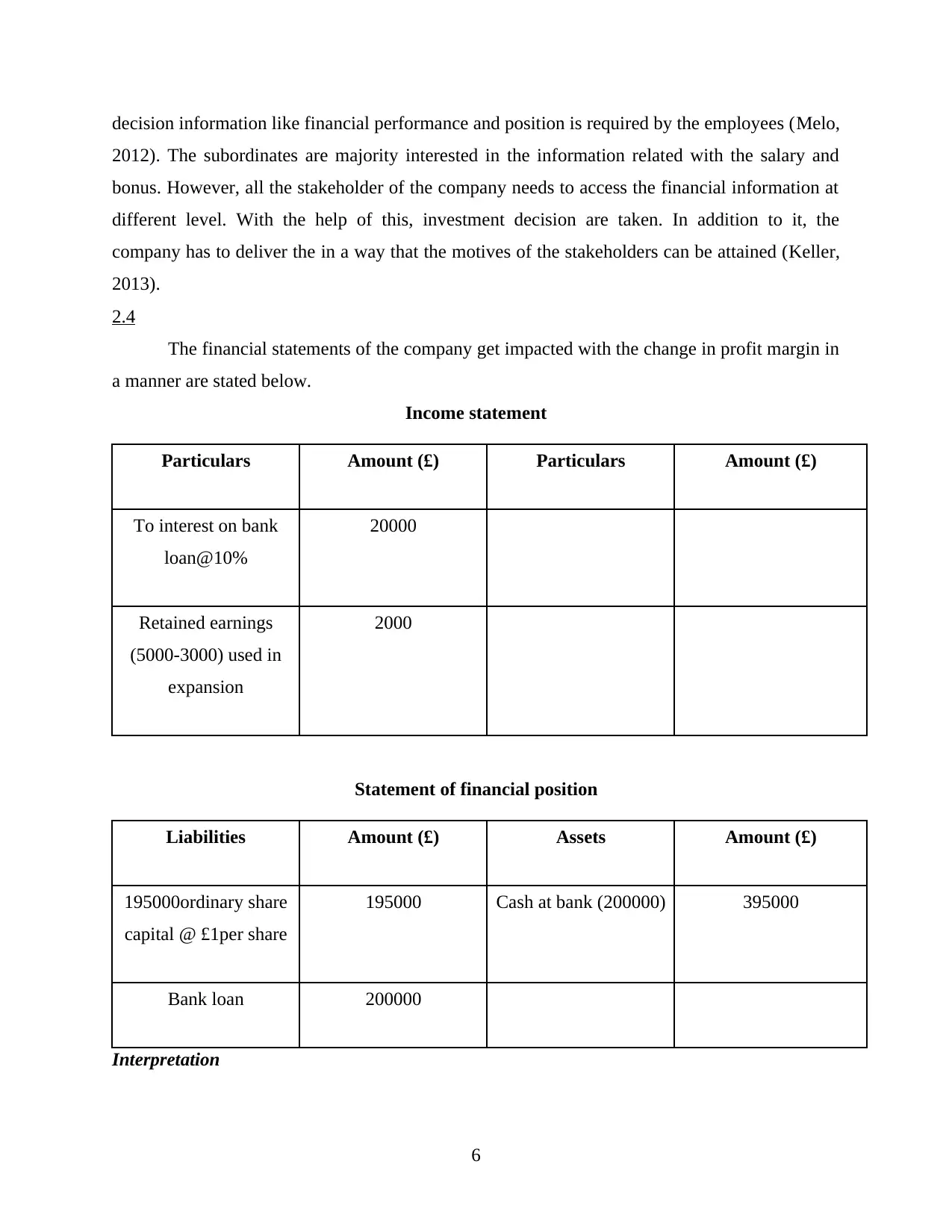
decision information like financial performance and position is required by the employees (Melo,
2012). The subordinates are majority interested in the information related with the salary and
bonus. However, all the stakeholder of the company needs to access the financial information at
different level. With the help of this, investment decision are taken. In addition to it, the
company has to deliver the in a way that the motives of the stakeholders can be attained (Keller,
2013).
2.4
The financial statements of the company get impacted with the change in profit margin in
a manner are stated below.
Income statement
Particulars Amount (£) Particulars Amount (£)
To interest on bank
loan@10%
20000
Retained earnings
(5000-3000) used in
expansion
2000
Statement of financial position
Liabilities Amount (£) Assets Amount (£)
195000ordinary share
capital @ £1per share
195000 Cash at bank (200000) 395000
Bank loan 200000
Interpretation
6
2012). The subordinates are majority interested in the information related with the salary and
bonus. However, all the stakeholder of the company needs to access the financial information at
different level. With the help of this, investment decision are taken. In addition to it, the
company has to deliver the in a way that the motives of the stakeholders can be attained (Keller,
2013).
2.4
The financial statements of the company get impacted with the change in profit margin in
a manner are stated below.
Income statement
Particulars Amount (£) Particulars Amount (£)
To interest on bank
loan@10%
20000
Retained earnings
(5000-3000) used in
expansion
2000
Statement of financial position
Liabilities Amount (£) Assets Amount (£)
195000ordinary share
capital @ £1per share
195000 Cash at bank (200000) 395000
Bank loan 200000
Interpretation
6
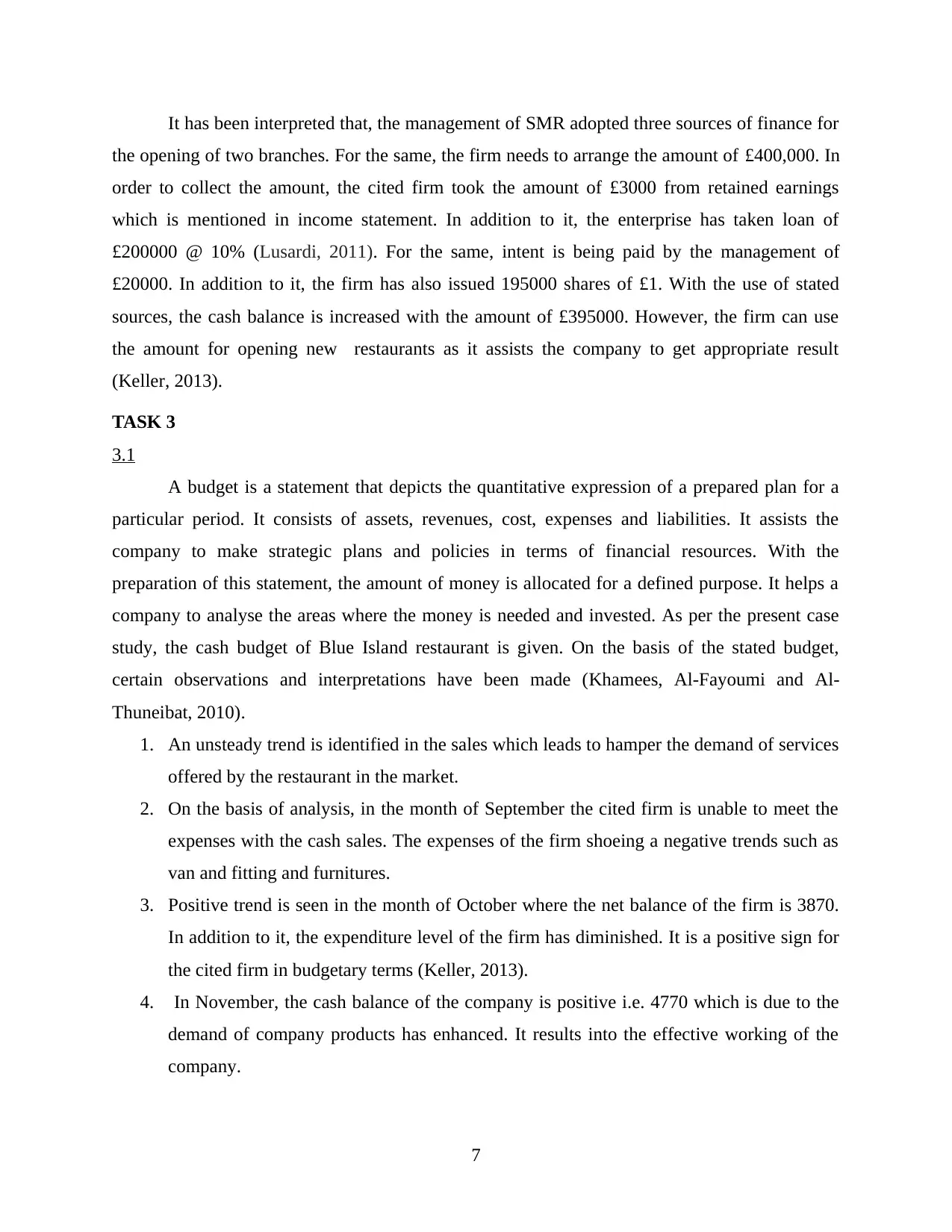
It has been interpreted that, the management of SMR adopted three sources of finance for
the opening of two branches. For the same, the firm needs to arrange the amount of £400,000. In
order to collect the amount, the cited firm took the amount of £3000 from retained earnings
which is mentioned in income statement. In addition to it, the enterprise has taken loan of
£200000 @ 10% (Lusardi, 2011). For the same, intent is being paid by the management of
£20000. In addition to it, the firm has also issued 195000 shares of £1. With the use of stated
sources, the cash balance is increased with the amount of £395000. However, the firm can use
the amount for opening new restaurants as it assists the company to get appropriate result
(Keller, 2013).
TASK 3
3.1
A budget is a statement that depicts the quantitative expression of a prepared plan for a
particular period. It consists of assets, revenues, cost, expenses and liabilities. It assists the
company to make strategic plans and policies in terms of financial resources. With the
preparation of this statement, the amount of money is allocated for a defined purpose. It helps a
company to analyse the areas where the money is needed and invested. As per the present case
study, the cash budget of Blue Island restaurant is given. On the basis of the stated budget,
certain observations and interpretations have been made (Khamees, Al-Fayoumi and Al-
Thuneibat, 2010).
1. An unsteady trend is identified in the sales which leads to hamper the demand of services
offered by the restaurant in the market.
2. On the basis of analysis, in the month of September the cited firm is unable to meet the
expenses with the cash sales. The expenses of the firm shoeing a negative trends such as
van and fitting and furnitures.
3. Positive trend is seen in the month of October where the net balance of the firm is 3870.
In addition to it, the expenditure level of the firm has diminished. It is a positive sign for
the cited firm in budgetary terms (Keller, 2013).
4. In November, the cash balance of the company is positive i.e. 4770 which is due to the
demand of company products has enhanced. It results into the effective working of the
company.
7
the opening of two branches. For the same, the firm needs to arrange the amount of £400,000. In
order to collect the amount, the cited firm took the amount of £3000 from retained earnings
which is mentioned in income statement. In addition to it, the enterprise has taken loan of
£200000 @ 10% (Lusardi, 2011). For the same, intent is being paid by the management of
£20000. In addition to it, the firm has also issued 195000 shares of £1. With the use of stated
sources, the cash balance is increased with the amount of £395000. However, the firm can use
the amount for opening new restaurants as it assists the company to get appropriate result
(Keller, 2013).
TASK 3
3.1
A budget is a statement that depicts the quantitative expression of a prepared plan for a
particular period. It consists of assets, revenues, cost, expenses and liabilities. It assists the
company to make strategic plans and policies in terms of financial resources. With the
preparation of this statement, the amount of money is allocated for a defined purpose. It helps a
company to analyse the areas where the money is needed and invested. As per the present case
study, the cash budget of Blue Island restaurant is given. On the basis of the stated budget,
certain observations and interpretations have been made (Khamees, Al-Fayoumi and Al-
Thuneibat, 2010).
1. An unsteady trend is identified in the sales which leads to hamper the demand of services
offered by the restaurant in the market.
2. On the basis of analysis, in the month of September the cited firm is unable to meet the
expenses with the cash sales. The expenses of the firm shoeing a negative trends such as
van and fitting and furnitures.
3. Positive trend is seen in the month of October where the net balance of the firm is 3870.
In addition to it, the expenditure level of the firm has diminished. It is a positive sign for
the cited firm in budgetary terms (Keller, 2013).
4. In November, the cash balance of the company is positive i.e. 4770 which is due to the
demand of company products has enhanced. It results into the effective working of the
company.
7
⊘ This is a preview!⊘
Do you want full access?
Subscribe today to unlock all pages.

Trusted by 1+ million students worldwide
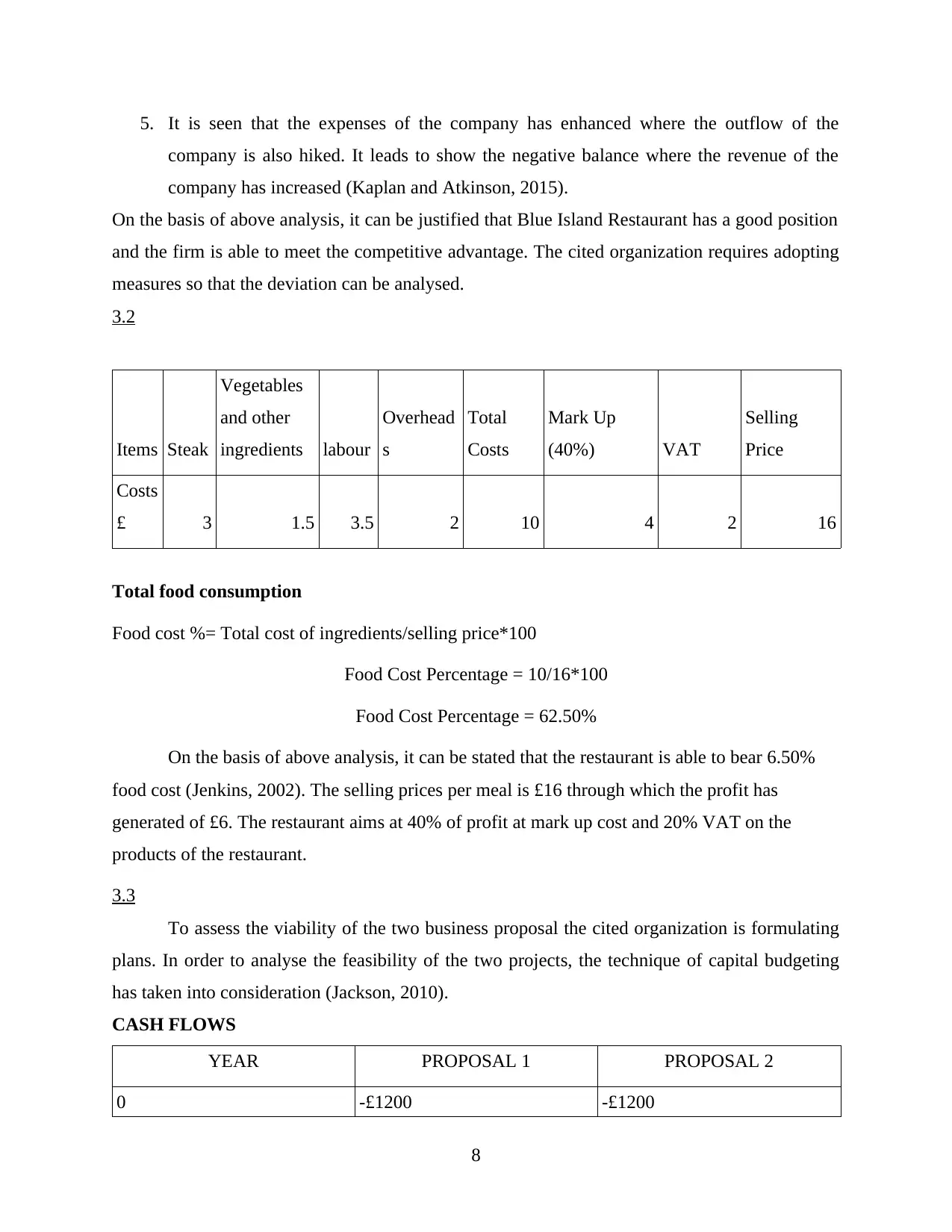
5. It is seen that the expenses of the company has enhanced where the outflow of the
company is also hiked. It leads to show the negative balance where the revenue of the
company has increased (Kaplan and Atkinson, 2015).
On the basis of above analysis, it can be justified that Blue Island Restaurant has a good position
and the firm is able to meet the competitive advantage. The cited organization requires adopting
measures so that the deviation can be analysed.
3.2
Items Steak
Vegetables
and other
ingredients labour
Overhead
s
Total
Costs
Mark Up
(40%) VAT
Selling
Price
Costs
£ 3 1.5 3.5 2 10 4 2 16
Total food consumption
Food cost %= Total cost of ingredients/selling price*100
Food Cost Percentage = 10/16*100
Food Cost Percentage = 62.50%
On the basis of above analysis, it can be stated that the restaurant is able to bear 6.50%
food cost (Jenkins, 2002). The selling prices per meal is £16 through which the profit has
generated of £6. The restaurant aims at 40% of profit at mark up cost and 20% VAT on the
products of the restaurant.
3.3
To assess the viability of the two business proposal the cited organization is formulating
plans. In order to analyse the feasibility of the two projects, the technique of capital budgeting
has taken into consideration (Jackson, 2010).
CASH FLOWS
YEAR PROPOSAL 1 PROPOSAL 2
0 -£1200 -£1200
8
company is also hiked. It leads to show the negative balance where the revenue of the
company has increased (Kaplan and Atkinson, 2015).
On the basis of above analysis, it can be justified that Blue Island Restaurant has a good position
and the firm is able to meet the competitive advantage. The cited organization requires adopting
measures so that the deviation can be analysed.
3.2
Items Steak
Vegetables
and other
ingredients labour
Overhead
s
Total
Costs
Mark Up
(40%) VAT
Selling
Price
Costs
£ 3 1.5 3.5 2 10 4 2 16
Total food consumption
Food cost %= Total cost of ingredients/selling price*100
Food Cost Percentage = 10/16*100
Food Cost Percentage = 62.50%
On the basis of above analysis, it can be stated that the restaurant is able to bear 6.50%
food cost (Jenkins, 2002). The selling prices per meal is £16 through which the profit has
generated of £6. The restaurant aims at 40% of profit at mark up cost and 20% VAT on the
products of the restaurant.
3.3
To assess the viability of the two business proposal the cited organization is formulating
plans. In order to analyse the feasibility of the two projects, the technique of capital budgeting
has taken into consideration (Jackson, 2010).
CASH FLOWS
YEAR PROPOSAL 1 PROPOSAL 2
0 -£1200 -£1200
8
Paraphrase This Document
Need a fresh take? Get an instant paraphrase of this document with our AI Paraphraser
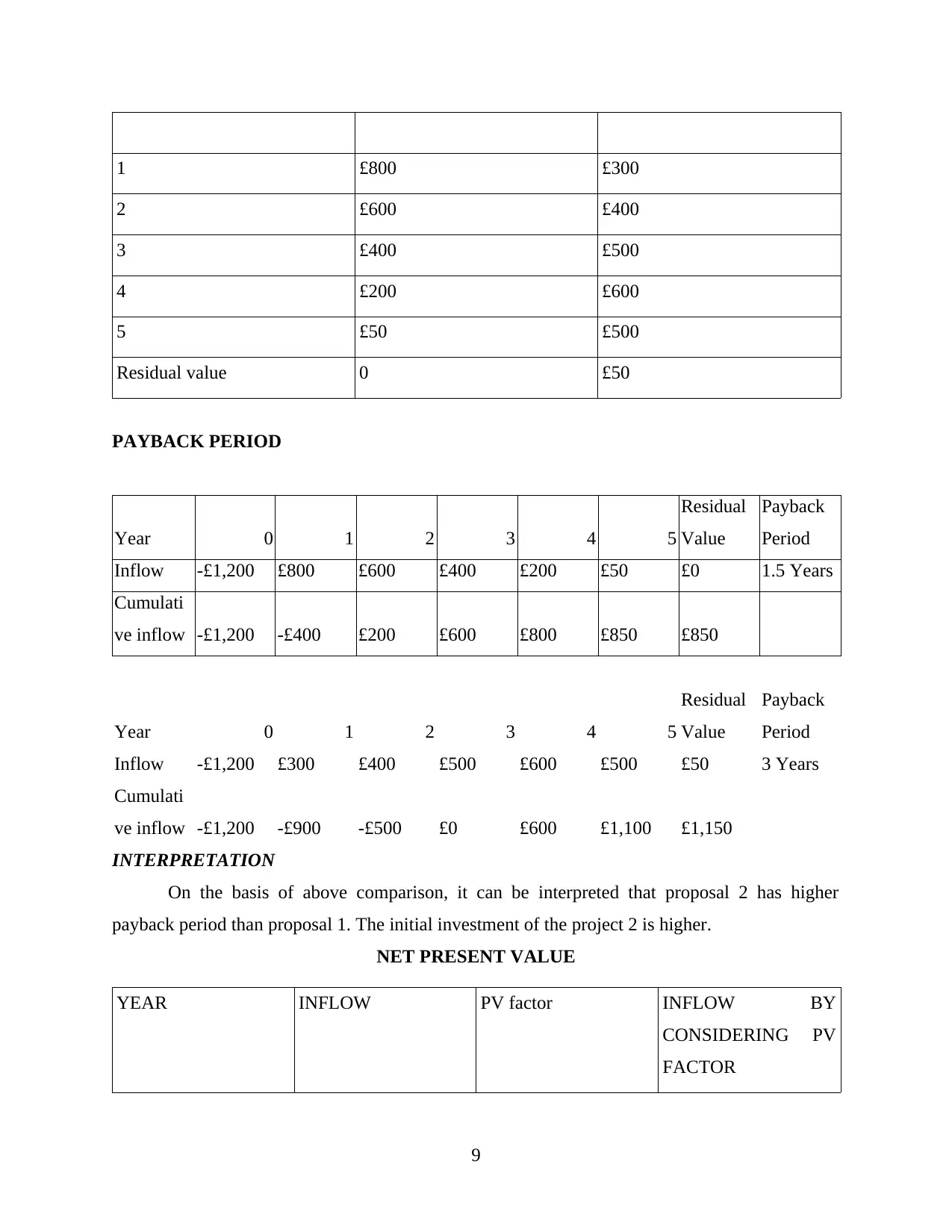
1 £800 £300
2 £600 £400
3 £400 £500
4 £200 £600
5 £50 £500
Residual value 0 £50
PAYBACK PERIOD
Year 0 1 2 3 4 5
Residual
Value
Payback
Period
Inflow -£1,200 £800 £600 £400 £200 £50 £0 1.5 Years
Cumulati
ve inflow -£1,200 -£400 £200 £600 £800 £850 £850
Year 0 1 2 3 4 5
Residual
Value
Payback
Period
Inflow -£1,200 £300 £400 £500 £600 £500 £50 3 Years
Cumulati
ve inflow -£1,200 -£900 -£500 £0 £600 £1,100 £1,150
INTERPRETATION
On the basis of above comparison, it can be interpreted that proposal 2 has higher
payback period than proposal 1. The initial investment of the project 2 is higher.
NET PRESENT VALUE
YEAR INFLOW PV factor INFLOW BY
CONSIDERING PV
FACTOR
9
2 £600 £400
3 £400 £500
4 £200 £600
5 £50 £500
Residual value 0 £50
PAYBACK PERIOD
Year 0 1 2 3 4 5
Residual
Value
Payback
Period
Inflow -£1,200 £800 £600 £400 £200 £50 £0 1.5 Years
Cumulati
ve inflow -£1,200 -£400 £200 £600 £800 £850 £850
Year 0 1 2 3 4 5
Residual
Value
Payback
Period
Inflow -£1,200 £300 £400 £500 £600 £500 £50 3 Years
Cumulati
ve inflow -£1,200 -£900 -£500 £0 £600 £1,100 £1,150
INTERPRETATION
On the basis of above comparison, it can be interpreted that proposal 2 has higher
payback period than proposal 1. The initial investment of the project 2 is higher.
NET PRESENT VALUE
YEAR INFLOW PV factor INFLOW BY
CONSIDERING PV
FACTOR
9

1 £800 £0.91 £727
2 £600 £0.83 £496
3 £400 £0.75 £300
4 £200 £0.68 £137
5 £50 £0.62 £31
Residual value 0 £0.62 0
Total inflow £1,691.00
Less: initial
investment
£1200
NPV £491.00
YEAR INFLOW PV FACTORS @10% INFLOW BY
CONSIDERING PV
FACTOR
1 £300 0.91 £273
2 £400 0.83 £330
3 £500 0.75 £376
4 £600 0.68 £410
5 £500 0.62 £310
Residual value £50 0.62 £31
Total inflow £1729.00
Less: initial
investment
£1200
Net present value £529
Interpretation
10
2 £600 £0.83 £496
3 £400 £0.75 £300
4 £200 £0.68 £137
5 £50 £0.62 £31
Residual value 0 £0.62 0
Total inflow £1,691.00
Less: initial
investment
£1200
NPV £491.00
YEAR INFLOW PV FACTORS @10% INFLOW BY
CONSIDERING PV
FACTOR
1 £300 0.91 £273
2 £400 0.83 £330
3 £500 0.75 £376
4 £600 0.68 £410
5 £500 0.62 £310
Residual value £50 0.62 £31
Total inflow £1729.00
Less: initial
investment
£1200
Net present value £529
Interpretation
10
⊘ This is a preview!⊘
Do you want full access?
Subscribe today to unlock all pages.

Trusted by 1+ million students worldwide
1 out of 18
Related Documents
Your All-in-One AI-Powered Toolkit for Academic Success.
+13062052269
info@desklib.com
Available 24*7 on WhatsApp / Email
![[object Object]](/_next/static/media/star-bottom.7253800d.svg)
Unlock your academic potential
Copyright © 2020–2025 A2Z Services. All Rights Reserved. Developed and managed by ZUCOL.





